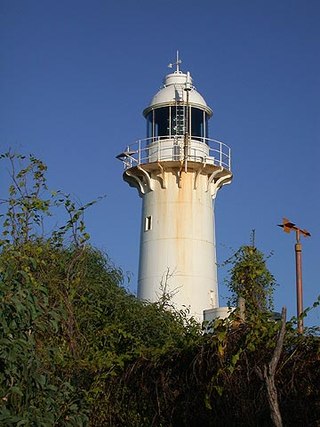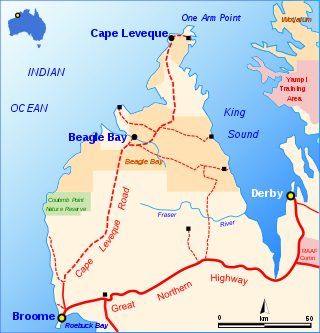
Broome, also known as Rubibi by the Yawuru people, is a coastal pearling and tourist town in the Kimberley region of Western Australia, 2,046 km (1,271 mi) north of Perth. The town recorded a population of 14,660 in the 2021 census. It is the largest town in the Kimberley region.
The Kimberley is the northernmost of the nine regions of Western Australia. It is bordered on the west by the Indian Ocean, on the north by the Timor Sea, on the south by the Great Sandy and Tanami deserts in the region of the Pilbara, and on the east by the Northern Territory.

The Cape York Peninsula is a peninsula located in Far North Queensland, Australia. It is the largest wilderness in northern Australia. The land is mostly flat and about half of the area is used for grazing cattle. The relatively undisturbed eucalyptus-wooded savannahs, tropical rainforests and other types of habitat are now recognised and preserved for their global environmental significance. Although much of the peninsula remains pristine, with a diverse repertoire of endemic flora and fauna, some of its wildlife may be threatened by industry and overgrazing as well as introduced species and weeds.

Denham is the administrative town for the Shire of Shark Bay, Western Australia. At the 2016 census, Denham had a population of 754. Located on the western coast of the Peron Peninsula 831 kilometres (516 mi) north of Perth, Denham is the westernmost publicly accessible town in Australia, and is named in honour of Captain Henry Mangles Denham of the Royal Navy, who charted Shark Bay in 1858. Today, Denham survives as the gateway for the tourists who come to see the dolphins at Monkey Mia, which is located 23 kilometres (14 mi) northeast of the town. The town also has an attractive beach and a jetty popular with those interested in fishing and boating.
Bardi is an endangered Australian Aboriginal language in the Nyulnyulan family, mutually intelligible with Jawi and possibly other dialects. It is spoken by the Bardi people at the tip of the Dampier peninsula and neighbouring islands. There are few fluent speakers in the 21st century, but efforts are being made to teach the Bardi language and culture at at least one school.
Broome Pearling Lugger Pidgin is a pidgin that sprang up in Broome, Western Australia in the early 20th century to facilitate communication between the various groups working in the pearling industry there—Japanese, Malays, Torres Strait Islanders, Koepangers, Hakka Chinese, Filipinos, Sri Lankans of Sinhalese and Tamil descent, a small number of Koreans, and local Indigenous Australians, mainly of the Bardi people but also Nyulnyul, Jabirr Jabirr, Jukun, Yawuru and Karajarri people. The name derives from the boats used for pearling, known as pearling luggers.

Cape Leveque is at the northernmost tip of the Dampier Peninsula in the Kimberley region of Western Australia. Cape Leveque is 240 kilometres (150 mi) north of Broome, and is remote with few facilities. Nevertheless, the Cape's sandy beaches are attracting an increasing number of visitors.

Pearling in Western Australia includes the harvesting and farming of both pearls and pearl shells along the north-western coast of Western Australia.

The Shire of Broome is one of the four local government areas in the Kimberley region of northern Western Australia, covering an area of 55,796 square kilometres (21,543 sq mi), most of which is sparsely populated. The Shire's estimated population as at the 2016 census was 16,222 most of whom reside in the town of Broome. Many Aboriginal communities are within the Shire, notably Beagle Bay and Bardi.
Beagle Bay is a medium-sized Aboriginal community on the western side of the Dampier Peninsula, north of Broome in the Kimberley region of Western Australia. Beagle Bay was named in 1838 by John Clements Wickham, captain of HMS Beagle.

The Cape Leveque Road is a regional Western Australian road that runs through pindan woodland for 205 kilometres (127 mi) between Broome and Cape Leveque on the Dampier Peninsula.

A Riji are the pearl shells traditionally worn by Aboriginal men in Northwest Australia. They are worn as pubic coverings, like a loin cloth, and attached with hairstring from a belt or band around the waist. Only men initiated to the highest degree could traditionally wear them. Today special ceremonies mark the occasion when boys are given riji to mark their transition to adulthood, a time of great joy for families.

The Northwest Shelf Province, also known as Exmouth to Broome, is a biogeographic region of Australia's continental shelf.
Ardyaloon or One Arm Point, also known as Bardi, is an Aboriginal Australian community town on the Dampier Peninsula, in the Kimberley region of Western Australia. It is located 2,446 kilometres (1,520 mi) north of Perth and the closest populated town is Derby. At the 2016 census, Bardi had a population of 365.
Lombadina is a medium-sized Aboriginal community on the north-western coast of Western Australia on Cape Leveque, north of Broome in the Kimberley region. The name is derived from the Aboriginal word, Lollmardinard. The community is inhabited by the Bardi people.
The Jabirr Jabirr language, also known as Djabirr-Djabirr, is a Western Nyulnyulan language formerly spoken by the Jabirr Jabirr people on the coast south of Beagle Bay in Western Australia. Earlier sources spelled the name DjaberrDjaberr or Dyaberdyaber; the contemporary accepted spelling is Jabirr-Jabirr, which reflects the spelling conventions of languages of the Kimberley region. It is also sometimes spelt Jabba Jabba.
Djarindjin is a medium-sized Aboriginal community located 170 km (110 mi) north of Broome in the Kimberley region of Western Australia, within the Shire of Broome. It is within the traditional lands of the Bardi and Jawi peoples.
Joe Nangan (1900-1989) was an Aboriginal Australian lawman, jalngunguru and artist. In his role as a custodian of legends, Nangan was responsible for the preservation of the sounds and performances of ceremonial dance and songlines. As an artist, he created hundreds of pencil and watercolour drawings, as well as incised pearl shells and boab nuts, that convey powerful connections to his Country.

The Bardi people, also spelt Baada or Baardi and other variations, are an Aboriginal Australian people, living north of Broome and inhabiting parts of the Dampier Peninsula in the Kimberley region of Western Australia. They are ethnically close to the Jawi people, and several organisations refer to the Bardi Jawi grouping, such as the Bardi Jawi Niimidiman Aboriginal Corporation Registered Native Title Body and the Bardi Jawi Rangers.
The Jabirr Jabirr are an Aboriginal Australian people of the Kimberley region of Western Australia.












